牛津重点小学英语语法复习完整版
上海牛津小学英语语法知识总结(最新整理)
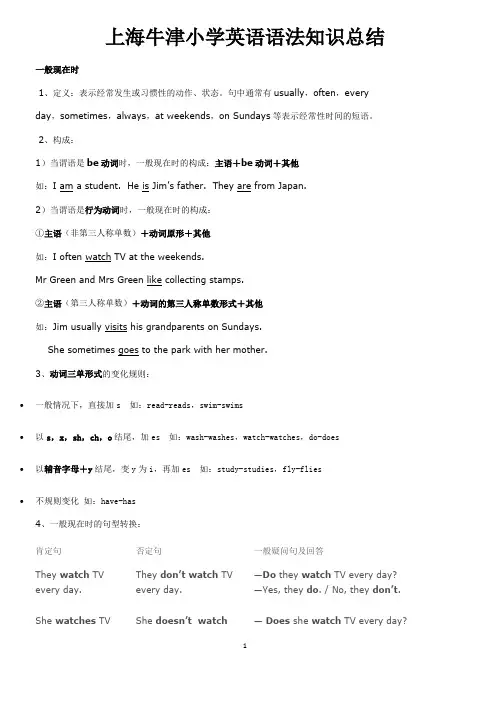
∙一般情况下,直接加s 如:read-reads,swim-swims∙以s,x,sh,ch,o结尾,加es 如:wash-washes,watch-watches,do-does ∙以辅音字母+y结尾,变y为i,再加es 如:study-studies,fly-flies∙不规则变化如:have-has4、一般现在时的句型转换:肯定句否定句一般疑问句及回答They watch TV every day.They don’t watch TVevery day.—Do they watch TV every day?—Yes, they do. / No, they don’t.She watches TV She doesn’t watch— Does she watch TV every day?every every day.—Yes, she does. / No, she doesn’t.现在进行时1、定义:表示现在或现阶段正在进行或发生的动作。
句中常有now,look,listen等词。
如:I am washing clothes now.Look! Liu Tao is climbing the tree.Listen! Jane is singing in the music room.2、构成:be动词(am/is/are)+ 动词现在分词(V-ing)3、动词现在分词构成:∙一般是在动词原形后加ing如:read-reading,drink-drinking,eat-eating,look-looking∙以不发音的e结尾的动词,去掉e,再加ing如:write-writing,make-making,ride-riding,take-taking∙以重读闭音节结尾,如末尾只有一个辅音字母,要双写这个字母,再加ing如:sit-sitting,swim-swimming,put-putting,run-running,stop-stopping,get-getting,begin-beginning,jog-jogging,forget-forgetting4、动名词其实就是动词的现在分词,它既有名词性质(可作主语),又有动词性质(可带宾语)。
牛津小学英语语法点汇总资料全
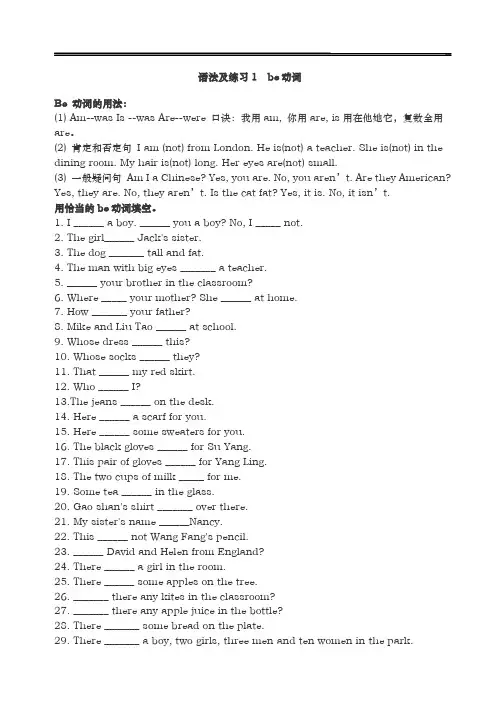
语法及练习1 be动词Be 动词的用法:(1) Am--was Is --was Are--were 口诀:我用am, 你用are, is用在他她它,复数全用are。
(2) 肯定和否定句I am (not) from London. He is(not) a teacher. She is(not) in the dining room. My hair is(not) long. Her eyes are(not) small.(3) 一般疑问句Am I a Chinese? Yes, you are. No, you aren’t. Are they American? Yes, they are. No, they aren’t. Is the cat fat? Yes, it is. No, it isn’t.用恰当的be动词填空。
1. I ______ a boy. ______ you a boy? No, I _____ not.2. The girl______ Jack's sister.3. The dog _______ tall and fat.4. The man with big eyes _______ a teacher.5. ______ your brother in the classroom?6. Where _____ your mother? She ______ at home.7. How _______ your father?8. Mike and Liu Tao ______ at school.9. Whose dress ______ this?10. Whose socks ______ they?11. That ______ my red skirt.12. Who ______ I?13.The jeans ______ on the desk.14. Here ______ a scarf for you.15. Here ______ some sweaters for you.16. The black gloves ______ for Su Yang.17. This pair of gloves ______ for Yang Ling.18. The two cups of milk _____ for me.19. Some tea ______ in the glass.20. Gao shan's shirt _______ over there.21. My sister's name ______Nancy.22. This ______ not Wang Fang's pencil.23. ______ David and Helen from England?24. There ______ a girl in the room.25. There ______ some apples on the tree.26. _______ there any kites in the classroom?27. _______ there any apple juice in the bottle?28. There _______ some bread on the plate.29. There _______ a boy, two girls, three men and ten women in the park.30. You, he and I ______ from China.语法及练习2 人称代词和物主代词人称代词和物主代词1.人称代词主格和宾格的区别:主格通常位于句中第一个动词之前(有时候位于than 之后),宾格一般位于动词或介词之后。
上海小学牛津英语语法归纳总结
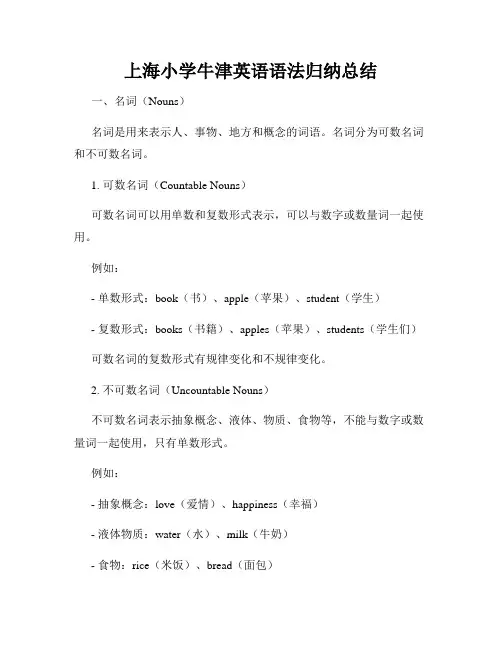
上海小学牛津英语语法归纳总结一、名词(Nouns)名词是用来表示人、事物、地方和概念的词语。
名词分为可数名词和不可数名词。
1. 可数名词(Countable Nouns)可数名词可以用单数和复数形式表示,可以与数字或数量词一起使用。
例如:- 单数形式:book(书)、apple(苹果)、student(学生)- 复数形式:books(书籍)、apples(苹果)、students(学生们)可数名词的复数形式有规律变化和不规律变化。
2. 不可数名词(Uncountable Nouns)不可数名词表示抽象概念、液体、物质、食物等,不能与数字或数量词一起使用,只有单数形式。
例如:- 抽象概念:love(爱情)、happiness(幸福)- 液体物质:water(水)、milk(牛奶)- 食物:rice(米饭)、bread(面包)不可数名词没有复数形式,不能直接与冠词a/an连用。
二、冠词(Articles)冠词用于限定名词的范围,分为定冠词和不定冠词。
1. 定冠词(Definite Article)定冠词是"the",用于特指已经提到的人或物,或者特指上下文中的某人或某物。
例如:- I saw a cat in the tree.(我看到树上有一只猫)- The cat was black.(那只猫是黑色的)2. 不定冠词(Indefinite Article)不定冠词有两种,分别是"a"和"an"。
用于泛指某一类人或物。
例如:- I have a dog.(我有一只狗)- She is an actress.(她是一名女演员)不定冠词"a"后面接辅音音素开头的词,"an"后面接元音音素开头的词。
三、形容词(Adjectives)形容词用来描述名词的特征和性质。
形容词通常位于名词之前。
- a big house(一个大房子)- a beautiful flower(一朵美丽的花)形容词可以用于比较级和最高级。
小学牛津英语语法大全精心整理版
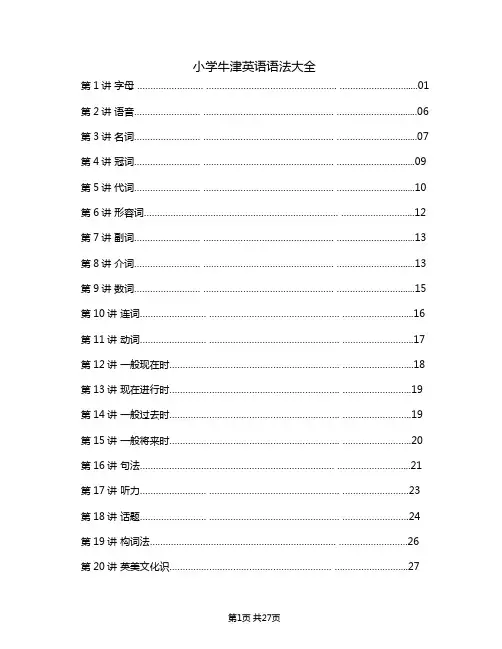
小学牛津英语语法大全第1讲字母......................... ................................................. (01)第2讲语音......................... ................................................. . (06)第3讲名词......................... ................................................. . (07)第4讲冠词......................... ................................................. (09)第5讲代词......................... ................................................. (10)第6讲形容词......................................................................... . (12)第7讲副词......................... ................................................. (13)第8讲介词......................... ................................................. (13)第9讲数词......................... ................................................. (15)第10讲连词......................... ................................................. (16)第11讲动词......................... ................................................. (17)第12讲一般现在时................................................................ (18)第13讲现在进行时................................................................ .. (19)第14讲一般过去时................................................................ .. (19)第15讲一般将来时................................................................ .. (20)第16讲句法......................................................................... . (21)第17讲听力......................... ................................................. . (23)第18讲话题......................... ................................................. . (24)第19讲构词法...................................................................... .. (26)第20讲英美文化识............................................................. . (27)第1讲字母1. 英语中共有26个字母。
上海牛津小学英语语法知识总结(最新整理)
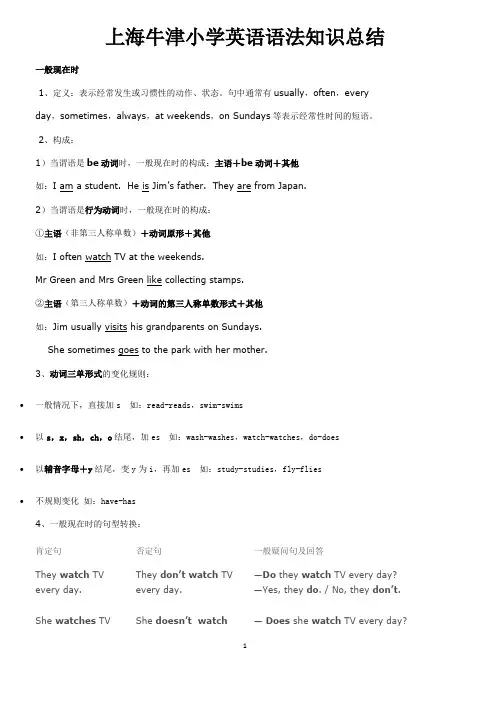
∙一般情况下,直接加s 如:read-reads,swim-swims∙以s,x,sh,ch,o结尾,加es 如:wash-washes,watch-watches,do-does ∙以辅音字母+y结尾,变y为i,再加es 如:study-studies,fly-flies∙不规则变化如:have-has4、一般现在时的句型转换:肯定句否定句一般疑问句及回答They watch TV every day.They don’t watch TVevery day.—Do they watch TV every day?—Yes, they do. / No, they don’t.She watches TV She doesn’t watch— Does she watch TV every day?every every day.—Yes, she does. / No, she doesn’t.现在进行时1、定义:表示现在或现阶段正在进行或发生的动作。
句中常有now,look,listen等词。
如:I am washing clothes now.Look! Liu Tao is climbing the tree.Listen! Jane is singing in the music room.2、构成:be动词(am/is/are)+ 动词现在分词(V-ing)3、动词现在分词构成:∙一般是在动词原形后加ing如:read-reading,drink-drinking,eat-eating,look-looking∙以不发音的e结尾的动词,去掉e,再加ing如:write-writing,make-making,ride-riding,take-taking∙以重读闭音节结尾,如末尾只有一个辅音字母,要双写这个字母,再加ing如:sit-sitting,swim-swimming,put-putting,run-running,stop-stopping,get-getting,begin-beginning,jog-jogging,forget-forgetting4、动名词其实就是动词的现在分词,它既有名词性质(可作主语),又有动词性质(可带宾语)。
上海牛津重点小学英语语法知识总结归纳
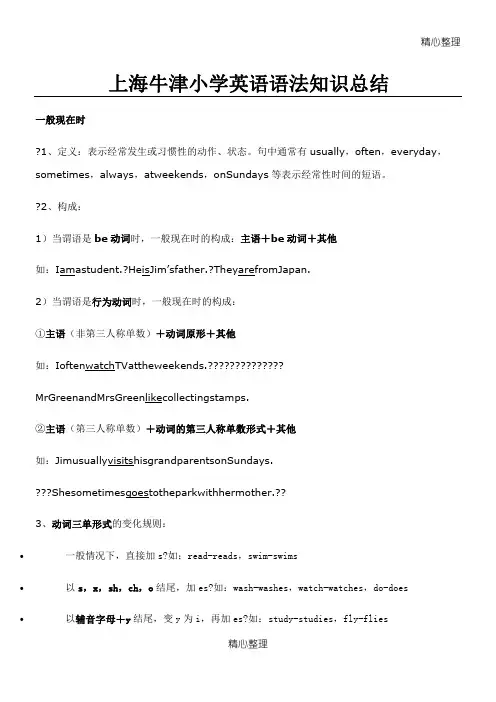
精心整理•一般情况下,直接加s?如:read-reads,swim-swims•以s,x,sh,ch,o结尾,加es?如:wash-washes,watch-watches,do-does•以辅音字母+y结尾,变y为i,再加es?如:study-studies,fly-flies•不规则变化如:have-has•4、一般现在时的句型转换:肯定句否定句一般疑问句及回答They watch TV everyday. They don’twatch TVeveryday.—Do they watch TVeveryday?—Yes,they do./No,they don’t.She watches TVShe doesn’t?watch—Does she watch TVeveryday?如:read-reading,drink-drinking,eat-eating,look-looking•以不发音的e结尾的动词,去掉e,再加ing如:write-writing,make-making,ride-riding,take-taking•以重读闭音节结尾,如末尾只有一个辅音字母,要双写这个字母,再加ing如:sit-sitting,swim-swimming,put-putting,run-running,stop-stopping,get-getting,2、构成:主语+动词的过去式+其他3、动词过去式的变化规则:肯定句否定句一般疑问句及回答—Did he watch TVyesterday? He watched TVyesterday. He didn’twatch TVyesterday.—Yes,he did./No,he didn’t.—Did they play gamesjustnow? They played gamesjustnow. They didn’tplay gamesjustnow.—Yes,they did./No,they didn’t. 一般将来时1、定义:表示将要发生的动作或存在的状态,以及打算、计划或准备某事。
牛津译林版小学英语五年级上学期语法知识点汇总
1.一般现在时- 动词的原形用于第三人称单数时,加s或es。
- He/She/It + 动词原形 + 其他。
- I/We/You/They + 动词原形 + 其他。
- 动词的否定句,在动词前加do not或doesn’t。
- 动词的一般疑问句,将助动词do/does置于句首。
-使用一般现在时,描述经常发生的事情、客观事实或普遍真理。
例句:- He eats an apple every day.(他每天吃一个苹果。
)- They play football on Saturdays.(他们在周六踢足球。
)- She doesn’t like carrots.(她不喜欢胡萝卜。
)- Do you go to school by bus?(你坐公交车上学吗?)- Does he have a pet dog?(他有一只宠物狗吗?)2.一般过去时-动词的过去式形式。
- 动词的过去式的构成规则:大多数动词加-ed或-d,部分规则发生变化。
例句:- I played basketball yesterday.(我昨天打篮球。
)- She didn’t wat ch TV last night.(昨晚她没看电视。
)- Did you visit your grandparents last weekend?(你上周末去看望你的祖父母了吗?)- Did they have breakfast at home this morning?(他们今天早上在家吃早餐了吗?)3.现在进行时- am/is/are + 动词的ing形式 + 其他。
-表示现在正在进行的动作。
-“现在正在进行”可以和“现在正在发生”混淆,要根据上下文进行判断。
例句:- She is eating lunch now.(她现在正在吃午饭。
)- They are playing basketball in the park.(他们正在公园打篮球。
小学牛津英语语法大全精心整理版
小学牛津英语语法大全第1讲字母......................... ................................................. (01)第2讲语音......................... ................................................. . (06)第3讲名词......................... ................................................. . (07)第4讲冠词......................... ................................................. (09)第5讲代词......................... ................................................. (10)第6讲形容词......................................................................... . (12)第7讲副词......................... ................................................. (13)第8讲介词......................... ................................................. (13)第9讲数词......................... ................................................. (15)第10讲连词......................... ................................................. (16)第11讲动词......................... ................................................. (17)第12讲一般现在时................................................................ (18)第13讲现在进行时................................................................ .. (19)第14讲一般过去时................................................................ .. (19)第15讲一般将来时................................................................ .. (20)第16讲句法......................................................................... . (21)第17讲听力......................... ................................................. . (23)第18讲话题......................... ................................................. . (24)第19讲构词法...................................................................... .. (26)第20讲英美文化识............................................................. . (27)第1讲字母1. 英语中共有26个字母。
牛津重点小学英语语法复习
牛津重点小学英语语法复习Revised final draft November 26, 2020牛津小学英语语法复习一、时态1.一般现在时(1)表示经常发生的动作或事情,通常用“usually,often,everyday,sometimes,always,never”等词。
2.现在进行时,(1)表示正在发生的动作,通常用“now,look”.(2)基本形式:be+动词+ingeg:Iam(not)doingmyhomework.You/We/Theyare(not)reading.He/She/Itis(not)eating.Whatareyoudoing?Ishereading?3.一般过去时态(1)表示过去已经发生的事情,通常用“lastweek,justnow,yesterday”等词。
(2)be动词的过去式:am/is—wasare—wereI/He/she/itwas(not)….You/we/theywere….一般疑问句was,were放在句首。
(4)动词过去式的变化:不规则动词的变化:原形过去式原形过去式原形过去式原形过去式sweep swept teach taught have had go went keep kept think thought do did find found sleep slept buy bought eat ate say said feel felt drink drank is/am was take took read read give gave are were mean meant put put sing sang drive drove meet met cut cut begin began speak spoke make made let let ring rang write wrote see saw fly flew run ran ride rode come came draw drew sit sat hear heard tell toldgrow grew learn learned/learntget got know knew4.一般将来时一般将来时表示将来打算做的事或将要发生的事情。
(完整)牛津小学英语语法点汇总),推荐文档
语法及练习1 be动词Be动词的用法:(1) Am--was Is --was Are--were 口诀:我用am,你用are, is用在他她它,复数全用are。
(2) 肯定和否定句I am (not) from London. He is(not) a teacher. She is(not) in the dining room.My hair is(not) long. Her eyes are(not) small.(3) 一般疑问句Am I a Chinese? Yes, you are. No, you aren ' t. Are they American? Yes, they are. No, they aren ' t. Is the cat fat? Yes, it is. No, it isn ' t.用恰当的be动词填空。
I. 1 ____ a boy. _____ you a boy? No, I ______ n ot.2. The girl ___ Jack's sister.3. The dog _______ t all and fat.4. The man with big eyes _____ a teacher.5. _____ y our brother in the classroom?6. Where ____ your mother? She ______ at home.7. How ______ your father?8. Mike and Liu Tao ______ a t school.9. Whose dress _____ this?10. Whose socks _____ they?II. That _____ my red skirt.12. Who _____ I?13. The jea ns ____ o n the desk.14. Here _____ a scarf for you.15. Here _____ some sweaters for you.16. The black gloves _____ f or Su Yang.17. This pair of gloves _____ for Yang Ling.18. The two cups of milk ___ for me.19. Some tea _____ i n the glass.20. Gao sha n's shirt _____ o ver there.21. My sister's n ame _____ N ancy.22. This _____ not Wang Fan g's pen cil.23. ____ D avid and Hele n from En gla nd?24. There ____ a girl in the room.25. There ____ some apples on the tree.26. _____ there any kites in the classroom?27. _____ there any apple juice in the bottle?28. There ______ some bread on the plate.29. There ______ a boy, two girls, three men and ten wome n in the park.30. You, he and I _____ from Chi na.语法及练习2人称代词和物主代词人称代词和物主代词1人称代词主格和宾格的区别:主格通常位于句中第一个动词之前(有时候位于t h a n之后),宾格一般位于动词或介词之后。
- 1、下载文档前请自行甄别文档内容的完整性,平台不提供额外的编辑、内容补充、找答案等附加服务。
- 2、"仅部分预览"的文档,不可在线预览部分如存在完整性等问题,可反馈申请退款(可完整预览的文档不适用该条件!)。
- 3、如文档侵犯您的权益,请联系客服反馈,我们会尽快为您处理(人工客服工作时间:9:00-18:30)。
牛津重点小学英语语法
复习
集团标准化办公室:[VV986T-J682P28-JP266L8-68PNN]
牛津小学英语语法复习
一、时态
1.一般现在时
(1)表示经常发生的动作或事情,通常用“usually,often,everyday,sometimes,always,never”等词。
2.现在进行时,
(1)表示正在发生的动作,通常用“now,look”.
(2)基本形式:be+动词+ing
eg:Iam(not)doingmyhomework.
You/We/Theyare(not)reading.
He/She/Itis(not)eating.
Whatareyoudoing?
Ishereading?
3.一般过去时态
(1)表示过去已经发生的事情,通常用“lastweek,justnow,yesterday”等词。
(2)be动词的过去式:am/is—wasare—were
I/He/she/itwas(not)….You/we/theywere….
一般疑问句was,were放在句首。
(4)动词过去式的变化:
不规则动词的变化:
原形过去式原形过去式原形过去式原形过去式sweep swept teach taught have had go went keep kept think thought do did find found sleep slept buy bought eat ate say said
feel felt drink drank is/am was take took read read give gave are were mean meant
put put sing sang drive drove meet met
cut cut begin began speak spoke make made
let let ring rang write wrote see saw
fly flew run ran ride rode come came draw drew sit sat hear heard tell told
grow grew learn learned/learn
t
get got know knew
4.一般将来时
一般将来时表示将来打算做的事或将要发生的事情。
常常与tomorrow,nextSunday等时间状语连用。
结构:begoingto+动词原形
例如:I’mgoingtovisitmygrandpanextweek.
二、人称代词
主格:I we you she he it they
宾格:me us you her him it them
形容词性物主代词:my our your her his its their
名词性物主代词:mine ours yours hers his its theirs
三、可数名词的复数形式
一般名词:+s abook–books
辅音字母加y结尾:-y+ies astory—stories
以s,sh,chorx结尾:+es aglass—glasses;awatch-watches
以o结尾:+s或+esapiano—pianosamango—mangoes
以f或fe结尾:-f或fe变为vesaknife–knivesashelf-shelves
四、不可数名词(没有复数形式)
bread,rice,water,juice,etc.
五、缩略形式
I’m=Iamyou’re=youareshe’s=sheishe’s=heis/hehas(got)
it’s=itiswho’s=whoiscan’t=cannotisn’t=isnotetc
didn’t=didnotweren’t=werenotwasn’t=wasnotlet’s=letus
六、不定冠词a/an
单词的第一读音是辅音读音:abook,apeach,a“U”
单词的第一个读音是元音读音:anegg,anhour,an“F”
七、介词
1.表示方位:on,in,infrontof,between,nextto,near,beside,at,behind.,under 2.表示时间:at:如:atsixo’clock,atChristmas,atweekends
on:如:onMondayon15th JulyonNationalDay
in:如:intheeveninginDecemberinwinter
八、基数词和序数词
one–firsttwo-secondthree-thirdfive-fifthnine-ninthtwelve-twelfth
twenty-twentieththirty-thirtiethforty-one–forty-first
Lesson3---thethirdlesson
九、some/any
肯定句:Ihavesometoysinmybedroom.
一般疑问句和否定句中:Doyouhaveanybrothersorsisters?
Hehasn’tgot anypencilsinhispencil-case.
询问想要什么时:Wouldyoulikesomejuice?
CanIhavesomestamps?
十、be动词
(1)Basicform(基本形式):am/are/is
(2)肯定和否定句be动词后加not:
Iam(not)fromLondon.
Myeyesare(not)small.
Myhairis(not)long.
(3)一般疑问句be动词提前:
AmIaChinese?Yes,youare.No,youaren’t. AretheyAmerican?Yes,theyare.No,theyaren’t.
Isthecatfat?Yes,itis.No,itisn’t.
(4)be动词的过去式:am/is—was,are—were
十一、therebe结构
肯定句:Thereisa…
Thereare…
一般疑问句:Isthere…
Yes,thereis./No,thereisn’t.
Arethere…Yes,thereare./No,therearen’t.
否定句:Thereisn’t….Therearen’t….
十二、祈使句
Sitdownplease
Don’tsitdown,please.
Let’sgotothepark.
十三、(情态)动词can,may,must,should,will后面直接用动词原形。
1.I/He/She/Theycansing.MayIcomein?Imustgonow.
2.Youshouldbequietinthelibrary.
3.You’llbegoodfriends.。
